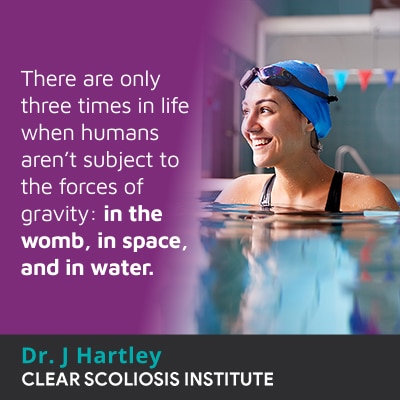
As scoliosis was first described and documented in the ancient world, the medical community has had many years to observe how it progresses, what triggers it to do so, and how the condition responds to treatment. Swimming can’t treat scoliosis, and while recreational swimming can offer some therapeutic benefits, certain aspects of swimming, and/or swimming competitively, aren’t recommended for some patients.
Swimming was once thought to be a form of treatment for scoliosis, but we’ve since learned that scoliosis progression is more about growth than gravity. Swimming can help with pain relief and working muscles symmetrically, but competitive swimming can be problematic for some people with scoliosis.
Before exploring the specifics of swimming with scoliosis, let’s first explore what makes a scoliotic spine vulnerable, and why not all activities are good for people with scoliosis.
Healthy spines have their vertebrae neutrally aligned and their natural curves are in place.
The spine’s healthy curves make it stronger and more capable of absorbing mechanical stress and engaging in a wide range of flexible movement.
As scoliosis involves the development of an unhealthy sideways-bending and rotating spinal curve, this causes a loss of its healthy curves and disrupts its biomechanics.
A scoliotic spine is unbalanced and unstable because scoliosis introduces a lot of uneven forces to the spine, its surroundings, and the body as a whole; this can disrupt spinal health and function, making it vulnerable to a number of issues.
Let’s talk more about how scoliosis affects the body because this is what makes some activities safe for scoliosis patients, while others should be approached with caution, or avoided entirely.
Each case of scoliosis is unique with many variables that differ from patient to patient, and this is why potentially-effective treatment plans need to be fully customized to address the specifics of each patient and their condition.
An important feature of scoliosis is its progressive nature; it’s virtually guaranteed to get worse over time, and this is triggered by growth.
Scoliosis getting worse means the size of the unnatural spinal curvature is increasing, and the condition’s uneven forces are increasing, along with their effects, and when it comes to children, the main effect is postural deviation, and in adults, we’re talking about pain.
In children, the earliest signs of scoliosis are often uneven shoulders and hips as the condition’s uneven forces interrupt the body’s natural symmetry; additional changes to watch for are uneven shoulder blades, the development of an arch in the rib cage, an uneven waistline, arms and legs that appear uneven, and changes to gait, balance, and coordination.
Scoliosis affects all ages, but the most prevalent type overall is adolescent idiopathic scoliosis, so when talking about childhood scoliosis, this is the age group I’m currently referencing.
Postural changes also affect adults, particularly an overt lean to one side that’s more visible when in a forward-bend position, but the main condition effect is pain, and this is because scoliosis becomes a compressive condition once skeletal maturity has been reached and the spine is no longer growing.
Growing spines are constantly being lengthened, and this motion counteracts the compressive force of the unnatural spinal curve; compression is uneven pressure, and compression of the spine and its surroundings is what causes the majority of condition-related pain.
Adults commonly come in for assessment and diagnosis due to back pain, and more often, pain that radiates into the hands and feet due to nerve compression.
Scoliosis ranges widely in severity from mild to moderate and severe, and in general, the more severe a condition, the more likely it is that activity restrictions will be necessary, but again, each case is unique.
So now that we’ve explored how the body generally responds to scoliosis, let’s talk specifically about swimming with scoliosis.
When people enquire about swimming and scoliosis, I find they are asking two things: is swimming an effective form of treatment for scoliosis, and is swimming a recommended activity for people with scoliosis.
As such a complex spinal condition that can range so widely in severity and type, there is no single generic treatment plan that can be applied to multiple patients, just as activity restrictions/recommendations will differ across the board.
So let’s start with the topic of swimming as a form of treatment because there was a time when swimming was thought of as a potential form of treatment; we didn’t know as much about the condition as we do today.

There are only three times in life when humans aren’t subject to the forces of gravity: in the womb, in space, and in water.
It makes sense that when less was understood about scoliosis, swimming could be seen as a potential form of treatment.
The condition’s underlying nature is structural, meaning it’s caused by an abnormality within the spine itself, so no activity or exercise has the potential to correct a scoliosis; however, certain activities/exercises do carry therapeutic benefits that can make the body more responsive to treatment.
Activities that strain the spine, place it in unnatural positions, exacerbate the condition’s asymmetrical effects, and/or involve repeated stress from impact are generally not recommended for people with scoliosis, particularly if severe.
We also know that body positioning (posture) is important for people with scoliosis, and swimming does involve arching the spine to breathe (butterfly stroke), and activities that unnaturally arch the spine introduce more adverse spinal tension.
Swimming, along with dance and gymnastics, is also associated with flattening of the thoracic curve, and this is thought capable of triggering progression, rather than slowing it.
So swimming can involve unhealthy spinal positions and can’t change the structure of an unnatural spinal curve; it can’t straighten it, nor can it stop or slow the condition’s progression, but what can it do?
There was also a time when it was thought that a diagnosis of scoliosis meant leading a sedentary life of limitations, but we now know that people don’t just survive scoliosis, but can thrive despite it, particularly when treated proactively.
While activity/exercise regimes always have to first be cleared by a patient’s treatment provider, when combined with other forms of treatment with corrective potential such as chiropractic care, they can help augment corrective treatment results.
So we know that exercise is important for people with scoliosis as a facet of conservative scoliosis treatment; we also know that exercise can help keep the spine strong and flexible, and staying active also helps keep the spine’s surrounding muscles strong and loose so they can optimally stabilize and support the spine.
In addition, engaging in regular and healthy spine-friendly activity helps patients stay fit and healthy, manage weight so there isn’t extra pressure on the spine, and can help to create a healing environment inside the body.

As an unnatural spinal curve is known to pull its surrounding muscles in different directions, this can lead to a muscle imbalance; the muscles on one side of the spine are strained from overuse, while muscles on the opposite side become weak from underuse.
The weaker and more unbalanced the spine’s surrounding muscles are, the less support and stabilization the spine receives, which is why increasing core strength through physical therapy and scoliosis-specific exercises is part of conservative treatment.
Swimming can also help improve the health of the spine’s intervertebral discs as exercise increases circulation, meaning important nutrients needed for disc repair are more available via their surroundings.
To be clear, the potential therapeutic benefits of swimming for people with scoliosis are associated with recreational swimming, not competitive; competitive swimming is not recommended for people with scoliosis for the aforementioned reasons.
Swimming casually a couple times a week for brief periods of time can help with short-term pain relief, symmetrical muscle development, and improve overall health and fitness, making the body more responsive to treatment, and patients better able to handle the rigors of treatment.
When it comes to scoliosis and swimming, the literature is mixed; in addition, as no two cases of scoliosis are exactly the same, activity restrictions one patient faces aren’t necessarily indicative of what others will experience.
While swimming can carry some therapeutic benefits when used as general exercise to work the back and abdominal muscles symmetrically, provide short-term pain relief, and improve patients’ overall fitness, competitive swimming is not generally recommended for scoliosis patients.
Activities that involve unnaturally arching the spine and/or flattening the spine’s largest section (thoracic spine) are not recommended for people with scoliosis, and swimming does involve arching and flattening the thoracic spine, which is why casual swimming can be approved for some patients, while competitive swimming is often restricted.
When it comes to scoliosis treatment, no one single discipline is enough to impact conditions on every level, so no single activity or type of exercise can treat scoliosis, but when integrated into a proactive conservative treatment plan, exercise can help augment corrective treatment results.
Here at the CLEAR Scoliosis Institute, we treat the whole patient, and that means not solely focusing on the spine, but also on providing lifestyle guidance to help patients find the perfect balance of scoliosis-friendly activities, activity levels, and determining whether or not activity restrictions are necessary.
When treated proactively with a conservative scoliosis treatment approach that combines condition-specific chiropractic care and a variety of therapies, scoliotic curves can be reduced in size, and as this happens, the spine is becoming more aligned and stable: a factor that greatly impacts overall quality of life.

CLEAR provides a unique and innovative way of understanding scoliosis. Sign up to receive facts and information you won’t find anywhere else.
